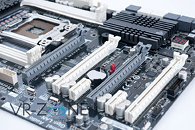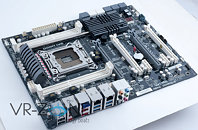- Joined
- Oct 9, 2007
- Messages
- 47,477 (7.50/day)
- Location
- Hyderabad, India
| System Name | RBMK-1000 |
|---|---|
| Processor | AMD Ryzen 7 5700G |
| Motherboard | ASUS ROG Strix B450-E Gaming |
| Cooling | DeepCool Gammax L240 V2 |
| Memory | 2x 8GB G.Skill Sniper X |
| Video Card(s) | Palit GeForce RTX 2080 SUPER GameRock |
| Storage | Western Digital Black NVMe 512GB |
| Display(s) | BenQ 1440p 60 Hz 27-inch |
| Case | Corsair Carbide 100R |
| Audio Device(s) | ASUS SupremeFX S1220A |
| Power Supply | Cooler Master MWE Gold 650W |
| Mouse | ASUS ROG Strix Impact |
| Keyboard | Gamdias Hermes E2 |
| Software | Windows 11 Pro |
Last week, ECS showed off its top-of-the-line HEDT (high-end desktop) segment motherboard in the making, the X79R-AX Black Series. This socket LGA2011 motherboard based on the Intel X79 chipset is expected to be launched along with the Core i7 "Sandy Bridge-E" processors. It targets the gamer-overclocker market, providing support for up to four graphics cards in 4-way SLI and CrossFire. The LGA2011 socket is powered by a 14-phase VRM, is is wired to four DDR3 DIMM slots on its either sides, supporting up to 32 GB of quad-channel DDR3 memory.
Expansion slots include four PCI-Express 3.0 x16, that can be electrically configured as x16/NC/x16/NC (single card or 2-way), x16/NC/x8/x8 (3-way), and x8/x8/x8/x8 (4-way). Other slots include two PCI-Express x1. Storage connectivity includes 12 internal SATA ports, and two eSATA. The data-rates of the internal ports are not known, but it most likely has two SATA 6 Gb/s and four SATA 3 Gb/s ports wired to the X79 PCH, while the remaining six ports are driven by additional SATA 6 Gb/s 2-port controllers. The eSATA ports run at 6 Gb/s.



The board is using cost-effective TI-made USB 3.0 controllers, there are four USB 3.0 ports on the rear panel, and two via a standard USB 3.0 internal header. The 8-channel HD audio is driven by a Realtek-made CODEC, which also gives out optical SPDIF through a TOSLINK connector. There are two gigabit Ethernet connections, both driven by Realtek 8111E chips. A few interesting connectivity addons bundled with this board are a Bluetooth dongle, and what appears to be a Wireless N USB adapter.
Overclocker-friendly features include CMOS-reset button on the rear-panel, diagnostic numerical display, diagnostic LEDs spread all over the board, consolidated voltage manual measurement points, and a thermometric strip over the chipset heatsink that gives out a very rough analog temperature reading. The chipset and VRM heatsinks are linked via a 6 mm-thick heat pipe. Power/reset buttons are on board. The X79R-AX most likely uses UEFI firmware.
View at TechPowerUp Main Site
Expansion slots include four PCI-Express 3.0 x16, that can be electrically configured as x16/NC/x16/NC (single card or 2-way), x16/NC/x8/x8 (3-way), and x8/x8/x8/x8 (4-way). Other slots include two PCI-Express x1. Storage connectivity includes 12 internal SATA ports, and two eSATA. The data-rates of the internal ports are not known, but it most likely has two SATA 6 Gb/s and four SATA 3 Gb/s ports wired to the X79 PCH, while the remaining six ports are driven by additional SATA 6 Gb/s 2-port controllers. The eSATA ports run at 6 Gb/s.



The board is using cost-effective TI-made USB 3.0 controllers, there are four USB 3.0 ports on the rear panel, and two via a standard USB 3.0 internal header. The 8-channel HD audio is driven by a Realtek-made CODEC, which also gives out optical SPDIF through a TOSLINK connector. There are two gigabit Ethernet connections, both driven by Realtek 8111E chips. A few interesting connectivity addons bundled with this board are a Bluetooth dongle, and what appears to be a Wireless N USB adapter.
Overclocker-friendly features include CMOS-reset button on the rear-panel, diagnostic numerical display, diagnostic LEDs spread all over the board, consolidated voltage manual measurement points, and a thermometric strip over the chipset heatsink that gives out a very rough analog temperature reading. The chipset and VRM heatsinks are linked via a 6 mm-thick heat pipe. Power/reset buttons are on board. The X79R-AX most likely uses UEFI firmware.
View at TechPowerUp Main Site










